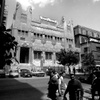Disclaimer
This entry contains information known to us from a variety of sources but may not include all the information currently available. Please be in touch if you notice any inadvertent mistakes in our presentation or have additional knowledge or sources to share. Thank you.
Archive
Shaar Hashamayim (Adly St.) Synagogue at Cairo, Egypt
The Adly (Adley) Street Synagogue, formerly known as the Sha'ar Hashamayim synagogue or the Ismailia Temple, was founded over 100 years ago in downtown Cairo on Adley Street.1 The Sha'ar Hashamayim, or the Gate of Heaven, was built in 1899 with a style evoking ancient Egyptian temples and was once the largest building on the wide downtown boulevard.2 It is said that Nessim Mosseri, with his wife Elena Mosseri (née Cattaui, one of the wealthiest Jewish families in Cairo), donated a part of their garden for the construction of the synagogue.3 The synagogue was designed by the architectural firm of Maurice Cattaui & Edward Matasek and was the location of many Cattaui weddings and funerals.4
Description
Synagogue: The downtown synagogue, Egypt's largest, is the only one still conducting services for the Jewish high holidays, which are occasionally attended by Israeli diplomats.5 The Egyptian Jewish community is one of the oldest Jewish communities in the world, with many notable Jews living in and around Cairo. Rabbi Moses Maimonides (the Rambam), for example, lived and taught in Fustat (Old Cairo) in the 13th century.6 For generations, hundreds of documents were collected in what became known as the Cairo Geniza, whose discovery in 1896 contributed much to Jewish historical research.7
Today, the Cairo Jewish community has between 30 and 40 members, most of them older women. One of them, Magda Haron (née Shahatah), recounts the last time she remembers the synagogue being full was in the 1960s,8 as Egypt's once-thriving Jewish community largely left the country during hostilities between Egypt and Israel.9
Cairo: The capital city of Egypt, Cairo, became the center of Jewish life in Egypt following the Crusades of 1168. Cairo's Jewish community lived primarily in the new city, in the Ḥārat al-Yahūd (Jewish quarter). Throughout the medieval period, Jews maintained their cultural traditions and relative political autonomy, and ultimately advanced economically into positions as craftsmen, traders, moneychangers, and physicians. However, the Mamluk era (1250 to 1517) marked a shift towards increasingly discriminatory laws against Jews and other religious minorities. This anti-Jewish discrimination continued through the Ottoman era and into the late eighteenth century, making life more regulated and difficult.
In the nineteenth century, Muḥammad ʿAlī and a series of other leaders governed Cairo as viceroys for the Ottoman sultan, improving security and economic development in Cairo. Despite several antisemitic publications and accusations published between 1844 and 1901, the Jewish community felt safer under the rule of Muḥammad ʿAlī than during other periods. Additionally, Cairo's Jewish population began to boom from about 3,000 in the early 1800s, to over 29,000 in 1917. Following Egypt's independence from Britain in 1922, the Jewish population in Cairo continued to grow, reaching 41,860 in 1947.
Unfortunately, antisemitism increased through the 1930s and 1940s as Nazi propaganda spread, the Young Egypt and Muslim Brotherhood movements grew in membership, and the newly established State of Israel defeated the Egyptian army. Consequently, Jews were often physically harmed or had their homes or businesses attacked, and by 1951 a large percentage of Cairo's Jewish population had left Egypt. Following the Sinai War of 1956 and the 1967 war, the majority of Cairo's remaining Jewish community had fled the country, often for Israel, France, or Italy. Today, only a few dozen, primarily elderly, Jews remain in Cairo.10
Sources
Notes
[1] Yoav Stern, "Cairo synagogue marks 100 years of grandeur and decline," Haaretz, November 4, 2007, accessed June 25, 2014, https://www.haaretz.com/2007-11-04/ty-article/cairo-synagogue-marks-100-years-of-grandeur-and-decline/0000017f-dc18-d3a5-af7f-febe710f0000.
[2] Samir Raafat, "The House of Yacoub Cattaui," Historical Society of Jews from Egypt, n.d., accessed June 24, 2014, https://www.hsje.org/Egypt/TheHouse-ofYacoubCattaui.html.
[3] Associated Press, "Bomb hurled at main synagogue in Cairo; no casualties" Haaretz, February 21, 2010, accessed June 25, 2014, https://www.haaretz.com/2010-02-21/ty-article/bomb-hurled-at-main-synagogue-in-cairo-no-casualties/0000017f-e4cf-d804-ad7f-f5ffcb6c0000.
[4] Samir Raafat.
[5] Associated Press.
[6] Ibid.
[7] Joel L. Kraemer, "Maimonides, Moses," Encyclopedia of Jews in the Islamic World, s.v., accessed June 26, 2014, <http://0-referenceworks.brillonline.com.luna.wellesley.edu/entries/encyclopedia-of-jews-in-the-islamic-world/maimonides-moses-COM_0014370>.
[8] Yoav Stern.
[9] Ibid, 4.
[10] Jacob M. Landau, "Cairo," Encyclopedia of Jews in the Islamic World, s.v. accessed June 26, 2014, http://referenceworks.brillonline.com/entries/encyclopedia-of-jews-in-the-islamic-world/cairo-COM_0004790.
Works Cited
Associated Press. "Bomb hurled at main synagogue in Cairo; no casualties." Haaretz. February 21, 2010. Accessed June 25, 2014. https://www.haaretz.com/2010-02-21/ty-article/bomb-hurled-at-main-synagogue-in-cairo-no-casualties/0000017f-e4cf-d804-ad7f-f5ffcb6c0000.
Kraemer, Joel L. "Maimonides, Moses." Encyclopedia of Jews in the Islamic World, s.v. Accessed June 26, 2014. http://0-referenceworks.brillonline.com.luna.wellesley.edu/entries/encyclopedia-of-jews-in-the-islamic-world/maimonides-moses-COM_0014370 .
Landau, Jacob M. "Cairo." Encyclopedia of Jews in the Islamic World, s.v. Accessed June 26, 2014. http://referenceworks.brillonline.com/entries/encyclopedia-of-jews-in-the-islamic-world/cairo-COM_0004790.
Raafat, Samir. "The House of Yacoub Cattaui." Historical Society of Jews from Egypt, N.d., accessed June 24, 2014, https://www.hsje.org/Egypt/TheHouse-ofYacoubCattaui.html.
Stern, Yoav. "Cairo synagogue marks 100 years of grandeur and decline," Haaretz. November 4, 2007. Accessed June 25, 2014, https://www.haaretz.com/2007-11-04/ty-article/cairo-synagogue-marks-100-years-of-grandeur-and-decline/0000017f-dc18-d3a5-af7f-febe710f0000.
Photos
Kosc, Zbigniew. "Sha'ar Hashamayim, aka Adley Street Synagogue." MusemofFamilyHistory.com. N.d. Accessed June 30, 2014, http://www.museumoffamilyhistory.com/s/s--zk-cairo-shaar-hashamayim.jpg.





























